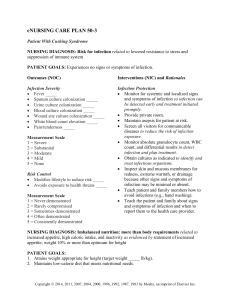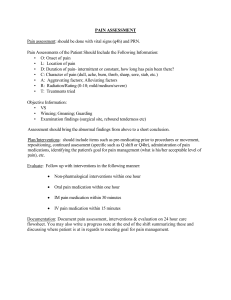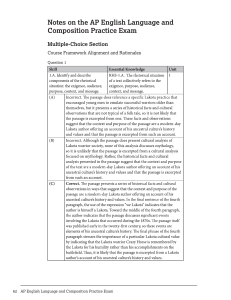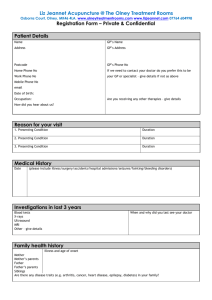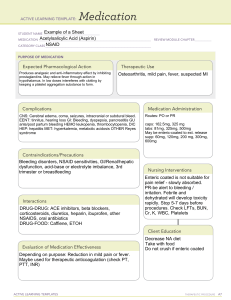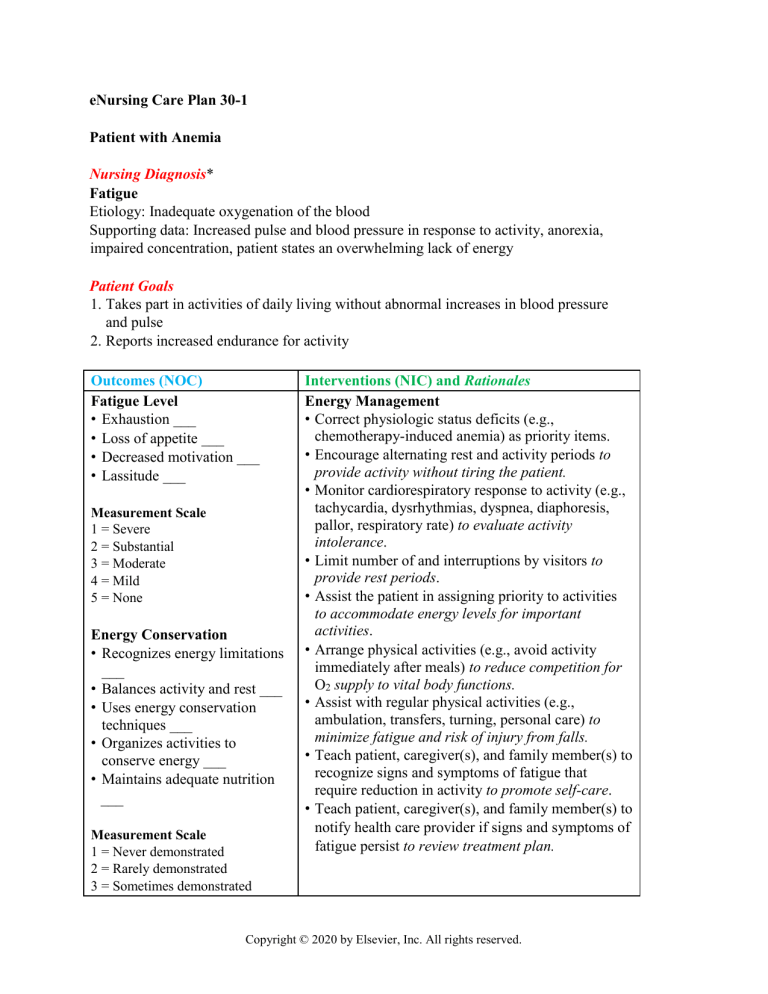
eNursing Care Plan 30-1 Patient with Anemia Nursing Diagnosis* Fatigue Etiology: Inadequate oxygenation of the blood Supporting data: Increased pulse and blood pressure in response to activity, anorexia, impaired concentration, patient states an overwhelming lack of energy Patient Goals 1. Takes part in activities of daily living without abnormal increases in blood pressure and pulse 2. Reports increased endurance for activity Outcomes (NOC) Fatigue Level • Exhaustion ___ • Loss of appetite ___ • Decreased motivation ___ • Lassitude ___ Measurement Scale 1 = Severe 2 = Substantial 3 = Moderate 4 = Mild 5 = None Energy Conservation • Recognizes energy limitations ___ • Balances activity and rest ___ • Uses energy conservation techniques ___ • Organizes activities to conserve energy ___ • Maintains adequate nutrition ___ Measurement Scale 1 = Never demonstrated 2 = Rarely demonstrated 3 = Sometimes demonstrated Interventions (NIC) and Rationales Energy Management • Correct physiologic status deficits (e.g., chemotherapy-induced anemia) as priority items. • Encourage alternating rest and activity periods to provide activity without tiring the patient. • Monitor cardiorespiratory response to activity (e.g., tachycardia, dysrhythmias, dyspnea, diaphoresis, pallor, respiratory rate) to evaluate activity intolerance. • Limit number of and interruptions by visitors to provide rest periods. • Assist the patient in assigning priority to activities to accommodate energy levels for important activities. • Arrange physical activities (e.g., avoid activity immediately after meals) to reduce competition for O2 supply to vital body functions. • Assist with regular physical activities (e.g., ambulation, transfers, turning, personal care) to minimize fatigue and risk of injury from falls. • Teach patient, caregiver(s), and family member(s) to recognize signs and symptoms of fatigue that require reduction in activity to promote self-care. • Teach patient, caregiver(s), and family member(s) to notify health care provider if signs and symptoms of fatigue persist to review treatment plan. Copyright © 2020 by Elsevier, Inc. All rights reserved. eNursing Care Plan 30-2 4 = Often demonstrated *Nursing diagnoses listed in order of priority. Outcomes (NOC) Interventions (NIC) and Rationales 5 = Consistently demonstrated Nursing Diagnosis Impaired Nutritional Status Etiology: Inadequate nutritional intake, anorexia Supporting data: Weight loss, low serum albumin level, decreased iron level, vitamin deficiencies Patient Goals 1. Maintains dietary intake that provides minimum daily requirements of nutrients 2. Attains normal blood values of nutrients necessary to prevent anemia Copyright © 2020 by Elsevier, Inc. All rights reserved. eNursing Care Plan 30-3 Outcomes (NOC) Nutritional Status • Nutrient intake ___ • Weight/height ratio ___ Nutritional Status: Biochemical Measures • Serum albumin ___ • Serum transferrin ___ • Hemoglobin ___ • Hematocrit ___ • Total iron-binding capacity ___ Interventions (NIC) and Rationales Nutrition Management • Determine, in collaboration with dietitian, number of calories and type of nutrients needed to meet nutritional requirements to plan interventions. • Teach patient to monitor calorie and dietary intake (i.e., food diary) to help evaluate nutritional intake. • Teach patient about nutritional needs (i.e., encourage increased intake of protein, iron, vitamin C) to provide nutrients needed for maximum iron absorption and hemoglobin production. • Adjust diet, as necessary, to adapt to changes in nutritional requirements. Measurement Scale 1 = Severe deviation from normal range 2 = Substantial deviation from normal range 3 = Moderate deviation from normal range 4 = Mild deviation from normal range 5 = No deviation from normal range Nursing Diagnosis Lack of Knowledge Etiology: Lack of knowledge about appropriate nutrition and medication regimen Supporting data: Questions about lifestyle adjustments, diet, medications Patient Goal States knowledge necessary to maintain adequate nutrition and management of medication regimen Outcomes (NOC) Interventions (NIC) and Rationales Copyright © 2020 by Elsevier, Inc. All rights reserved. eNursing Care Plan 30-4 Knowledge: Healthy Diet • Recommended nutritional guidelines ___ • Nutrient intake appropriate for individual needs ___ • Foods consistent with nutritional guidelines ___ • Potential food and medication interactions ___ Knowledge: Medication • Correct name of medication(s) ___ • Medication therapeutic effects ___ • Medication adverse effects ___ • Correct use of prescribed medication ___ • Required laboratory tests for monitoring medication ___ Nutritional Counseling • Facilitate identification of eating behaviors to be changed. • Use accepted nutritional standards to assist patient in evaluating adequacy of dietary intake • Discuss nutritional requirements and patient’s perceptions of prescribed or recommended diet. • Provide referral or consultation with other members of the health care team to help patient achieve goals and make adjustments throughout recovery. • Review with patient measurements of hemoglobin values to evaluate response to therapeutic plan. Teaching: Prescribed Medication • Teach the patient the purpose and action of each medication. • Teach the patient the dosage, route, and duration of each medication to improve adherence. • Teach the patient possible adverse effects of each medication to ensure early detection of adverse responses to medication. Measurement Scale 1 = No knowledge 2 = Limited knowledge 3 = Moderate knowledge 4 = Substantial knowledge 5 = Extensive knowledge eNursing Care Plan 30-2 Patient with Thrombocytopenia Nursing Diagnosis* Impaired Oral Mucous Membranes Etiology: Low platelet counts, effects of pathologic conditions and treatment Supporting data: Gingival bleeding, oral lesions Patient Goal Maintains lesion-free oral mucosa without bleeding Outcomes (NOC) Interventions (NIC) and Rationales Copyright © 2020 by Elsevier, Inc. All rights reserved. eNursing Care Plan 30-5 Oral Health • Bleeding ___ • Oral mucosa lesions ___ Measurement Scale 1 = Severe 2 = Substantial 3 = Moderate 4 = Mild 5 = None Oral Health Restoration • Monitor condition of patient’s mouth (e.g., lips, tongue, mucous membranes, teeth, and gums) including character of abnormalities (e.g., size, color, and location of internal or external lesions or inflammation, and other signs of infection) to provide information for planning interventions. • Encourage avoidance of spicy, salty, acidic, dry, rough, or hard foods to decrease irritation of oral mucosa. • Teach patient to use soft-bristled toothbrush or disposable mouth sponge to remove dental debris while preventing irritation of oral mucosa. • Teach patient, caregiver(s), or family member(s) on frequency and quality of proper oral health care to avoid breakdown of oral mucosa. • Teach patient to avoid oral hygiene products containing glycerin, alcohol, or other drying agents to prevent excessive drying of the mucosa. Nursing Diagnosis Risk for Bleeding Risk factors: Decreased platelets, treatment-related side effects, inherent coagulopathies Patient Goals 1. Maintains tissue integrity 2. Has no evidence of bleeding or bruising Outcomes (NOC) Blood Coagulation Bleeding ___ Interventions (NIC) and Rationales Bleeding Precautions Monitor for signs and symptoms of persistent *Nursing diagnoses listed in order of priority. Outcomes (NOC) Interventions (NIC) and Rationales Copyright © 2020 by Elsevier, Inc. All rights reserved. eNursing Care Plan • • • • • • 30-6 Bruising ___ Petechiae ___ Ecchymosis ___ Purpura ___ Hematuria ___ Hemoptysis ___ • • Measurement Scale 1 = Severe 2 = Substantial 3 = Moderate 4 = Mild 5 = None • • • • • bleeding (i.e., check all secretions for frank or occult blood) to detect internal bleeding. Monitor coagulation studies, including prothrombin time (PT), partial thromboplastin time (PTT), fibrinogen, fibrin degradation/split products, and platelet counts, to determine bleeding risk. Avoid injections (IV, IM, subcutaneous) to prevent bleeding into tissue surrounding puncture site. Have patient use electric razor instead of straightedge razor blade for shaving to reduce potential for skin nicks. Protect patient from trauma to reduce tissue damage and subsequent bleeding into tissue. Administer blood products (e.g., platelets, fresh frozen plasma) to replace coagulation factors. Tell patient to avoid invasive procedures; if they are necessary, monitor closely for bleeding, to reduce potential for internal bleeding. Teach patient and/or caregiver(s) to avoid aspirin or other anticoagulants to prevent additional bleeding risk. Nursing Diagnosis Lack of Knowledge Etiology: Lack of information about the disease process, activity, and medication Supporting data: Questions about disease management, anxiety, restlessness Patient Goal States required knowledge and skills to manage disease process at home Outcomes (NOC) Knowledge: Disease Process • Characteristics of specific disease ___ • Cause and contributing factors ___ • Signs and symptoms of disease ___ • Usual course of disease process ___ • Signs and symptoms of disease complications ___ • Benefits of disease management ___ Interventions (NIC) and Rationales Teaching: Disease Process • Assess patient’s current level of knowledge related to specific disease process to plan appropriate interventions. • Describe disease process. • Describe common signs and symptoms of the disease so patient will know what to expect. • Discuss treatment/therapy options to decrease anxiety and prevent complications. • Discuss lifestyle changes that may be required to prevent future complications and/or control the disease process so patient will be informed and able to manage self-care or direct others in care. Copyright © 2020 by Elsevier, Inc. All rights reserved. eNursing Care Plan Outcomes (NOC) Measurement Scale 1 = No knowledge 2 = Limited knowledge 3 = Moderate knowledge 4 = Substantial knowledge 5 = Extensive knowledge 30-7 Interventions (NIC) and Rationales • Refer patient to local community agencies/support groups for continued education and support. • Provide the phone numbers to call if complications occur to enable control of complications. Copyright © 2020 by Elsevier, Inc. All rights reserved. eNursing Care Plan 30-8 eNursing Care Plan 30-3 Patient with Neutropenia Nursing Diagnosis Risk for Infection Risk factors: Inadequate secondary defenses (immunosuppression), altered response to microbial invasion, environmental exposure to pathogens Patient Goals 1. Adheres to infection control and protection practices 2. Has no signs or symptoms of infection, reducing the risk of septic shock Outcomes (NOC) Interventions (NIC) and Rationales Copyright © 2020 by Elsevier, Inc. All rights reserved. eNursing Care Plan 30-9 Risk Control: Infectious Process • Acknowledges personal risk factors for infection ___ • Identifies infection risk in daily activities ___ • Identifies strategies to protect self from others with infection ___ • Monitors environment for factors associated with infection risk ___ • Develops effective infection control strategies ___ • Practices infection control strategies ___ • Monitors changes in general health status ___ Measurement Scale 1 = Never demonstrated 2 = Rarely demonstrated 3 = Sometimes demonstrated 4 = Often demonstrated 5 = Consistently demonstrated Infection Protection • Maintain isolation techniques, as appropriate, to reduce patient’s exposure to environmental pathogens. • Screen all visitors for communicable disease to prevent the transmission of harmful pathogens to patient. • Remove fresh flowers and plants from patient areas to avoid introduction of pathogens. • Follow neutropenic precautions to avoid patient exposure to pathogens. • Monitor for signs and symptoms of systemic and localized infection to promote early detection of infection. • Monitor laboratory test results for absolute granulocyte count, WBC count, and differential to identify signs of and potential for infection. • Inspect skin and mucous membranes for redness, extreme warmth, or drainage to detect infection. • Teach patient, caregiver(s), and family member(s) personal hygiene techniques of hand washing, oral care, skin hygiene, and pulmonary hygiene to avoid infection. • Teach the patient, caregiver(s), and family member(s) about signs and symptoms of infection and when to report them to the health care provider to receive early treatment of infection. • Report suspected infections to infection control personnel to promptly initiate antibiotic therapy. • Teach patient to take antibiotics as prescribed to prevent microbial resistance. Copyright © 2020 by Elsevier, Inc. All rights reserved.
